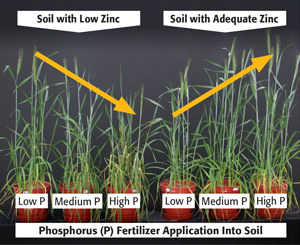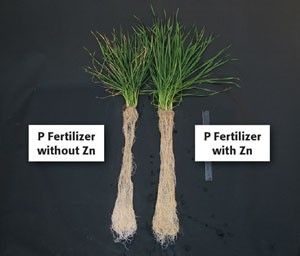
Exhibition time: 17-19 March, 2026 Shanghai, China
 中文
中文

Exhibition time: 17-19 March, 2026 Shanghai, China
 中文
中文
Introduction
Phosphorus (P) fertilizer is often added to cropping systems to increase yield, but growers should not overlook the importance of micronutrients like Zinc (Zn). Understanding some of the nutrient interactions that affect nutrient availability can help with management decisions like fertilizer source. The interaction of P and Zn has been well researched and documented in the fields of soil chemistry and plant nutrition. For example, research shows that high rates of P fertilizer without adequate plant available Zn can reduce Zn uptake by the roots, induce Zn deficiency, and decrease plant growth and yield. When making decisions for a soil fertility program, it is important to consider some of the factors and situations that may cause P-Zn antagonism and how to best avoid or minimize those factors.
Causes of Negative P-Zn Interaction
Formation of Insoluble Zn-Phosphate Complexes
One of the primary causes of Zn deficiency in soils treated with high amounts of P fertilizer is its reaction with soluble Zn in the soil. This reaction produces insoluble Zn-phosphate complexes which influences the availability of Zn for plant uptake over time (Mortvedt, 1991). A potential outcome is a reduction of Zn availability leading to Zn deficiency and reduced plant growth.
Role of Mycorrhizae in causing Zn Deficiency in Plants
Mycorrhizae are beneficial fungi that form a symbiotic association with roots. Mycorrhizal fungi play an important role in plant nutrient uptake (particularly P and Zn) by extending hyphae (e.g., a fungi produced root-like structure) horizontally and deeper into the soil where plant roots normally can’t reach. These fungi allow plant roots to have a greater surface area for increased water and nutrient uptake capacity. In terms of Zn, mycorrhizae may be responsible for up to 50% of the total Zn uptake in crop plants (Marschner, 2012). When high rates of P are applied, hyphae become “lazy” and the overall root footprint is decreased, resulting in a reduction of Zn uptake by the plant. High P application rates may, therefore, reduce Zn uptake mainly due to the reduced mycorrhizae-dependent Zn uptake.
Situations Where Negative P-Zn Interaction Occurs
Antagonistic P-Zn interactions can occur when soils receive high P application rates or those that are very low in plant available Zn. For example, a greenhouse study using a calcareous soil with low plant available Zn discovered that high P application rates induced Zn deficiency and reduced plant growth. In contrast, plants that received adequate Zn did not show any Zn deficiency and responded positively to higher P rates (Fig. 1).

Fig. 1: Growth of wheat plants with increased P rates having low soil Zn supply (left) and adequate soil Zn supply (right).
(Ova et al., 2015, Plant and Soil).
Soil Test Zinc
Soil test Zn is commonly measured using a DTPA extraction. Extensive calibration tests conducted across a diverse set of soils in the US has found that DTPA-Zn concentration in soil is very well correlated with the root uptake of zinc. Soil test laboratories often recommend the application of Zn in soils where values fall below 0.7 – 1.0 ppm. Many high-yield systems where high-rates of P are applied to match removal values may find a benefit from applications of Zn even when
soil test Zn values are above these critical levels.

Fig. 2: Effect of P fertilizer without and with Zn on shoot and root growth of wheat with low soil Zn content
(Pictures: M. Yazici and I. Cakmak, Sabanci University).

Importance of Zn Application along with a P Fertilizer
Due to the negative P-Zn interaction, maintaining proper Zn nutrition is critical, especially when soils receive P fertilizer. It is, therefore, not surprising why wheat (Fig. 2) or corn (Fig. 3) treated with P fertilizer co-granulated with Zn resulted in better growth and yield than plants that received P without Zn. Applying Zn-containing P fertilizers not only improved shoot growth, but demonstrated root growth improvements as well.
Conclusions
The addition of P fertilizer without adequate Zn can reduce crop growth and yield. Research suggests that two of the key reasons are: 1) negative P-Zn interaction and the formation of insoluble Zn-Phosphate complexes and 2) reduced mycorrhizal activity. The negative effect is magnified under conditions where soil Zn supply is very low and P application rates are high. Improved plant growth response to P was realized when the Zn supply was sufficient or when Zn was co-granulated with P fertilizer. Therefore, application of Zn-containing P fertilizers like MicroEssentials® SZ® (12-40-0-10S-1Zn) can be successful in reducing or eliminating the Zn deficiency and realize a greater response to applied P.
From Mosaic
